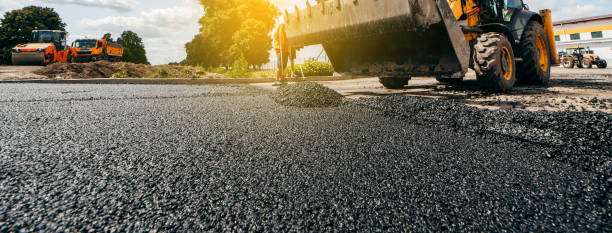Asphalt is more than the black surface beneath our tyres—it is a carefully engineered material that combines science, engineering, and sustainability. From motorways to suburban streets, asphalt provides the durable surfaces that underpin modern transport and urban development. While it is often taken for granted, the mix design and production of asphalt are highly complex, involving the interplay of binders, aggregates, and, increasingly, recycled materials.
The Basics of Hot-Mix Asphalt (HMA)
Hot-mix asphalt is the most widely used pavement material worldwide. As the name suggests, it is produced by heating asphalt binders and aggregates to high temperatures before mixing them together to create a consistent, workable product. The mixture is then laid, compacted, and cooled to form the smooth, resilient surfaces we drive on daily.
HMA’s strength lies in its flexibility and durability. Unlike rigid pavements, asphalt layers can absorb and distribute loads, reducing the risk of cracking under pressure. The science behind HMA comes down to two key components: the binder and the aggregate.
Asphalt Binders: The Glue of the Mix
The binder is the “glue” that holds everything together. Traditionally, this binder is bitumen, a by-product of petroleum refining. When heated, bitumen becomes viscous, coating the aggregate particles before cooling and hardening into a durable, water-resistant material.
Different grades of bitumen are selected based on performance requirements. Softer binders may be used in colder climates to prevent cracking, while stiffer binders are favoured in hot regions to resist rutting. Modified binders, which incorporate polymers or additives, are increasingly used to enhance flexibility, durability, and resistance to temperature extremes.
Aggregates: The Framework of Strength
Aggregates make up roughly 90–95% of HMA by weight. These are crushed stones, gravels, or sands that provide the structural backbone of the pavement. Their size, shape, and gradation directly impact the performance of the asphalt.
- Coarse aggregates contribute strength and load-bearing capacity.
- Fine aggregates fill voids and improve stability.
- Mineral fillers such as lime or fly ash improve binder adhesion and moisture resistance.
Together, these elements create a dense, interlocked matrix that resists deformation under traffic and environmental stresses.
The Move Toward Sustainability
While traditional HMA remains the industry standard, growing pressure for greener infrastructure is reshaping asphalt design. Engineers are increasingly turning to recycled materials to reduce reliance on virgin resources, cut costs, and lower environmental impacts.
Two of the most widely used recycled inputs are Reclaimed Asphalt Pavement (RAP) and Recycled Asphalt Shingles (RAS).
Reclaimed Asphalt Pavement (RAP)
RAP is produced by milling or crushing existing asphalt surfaces during resurfacing projects. Instead of discarding this material, it is processed and reintroduced into new asphalt mixes. RAP contains both aggregate and aged binder, which can partially replace virgin materials.
Benefits of RAP include:
- Sustainability: Reduces demand for new aggregates and bitumen.
- Cost efficiency: Lowers material expenses.
- Performance: When properly processed, RAP can perform as well as or better than virgin mixes.
The proportion of RAP that can be included varies by project requirements and local specifications, but advances in binder rejuvenation technologies are enabling higher usage rates without compromising quality.
Recycled Asphalt Shingles (RAS)
RAS comes from manufacturing scrap or post-consumer roofing shingles. These contain high-quality asphalt and fine aggregates, making them valuable additions to new mixes. Even small amounts of RAS can enhance stiffness and rutting resistance while reducing costs.
When combined with RAP, RAS contributes to a circular economy, diverting significant waste from landfills.
Balancing Sustainability and Performance
Incorporating recycled materials into HMA is not without its challenges. Recycled binders are stiffer than virgin binders, which can increase the risk of cracking if not balanced correctly. This has led to the rise of rejuvenators—chemical additives that restore flexibility to aged binders.
Engineers must also carefully monitor aggregate gradation, moisture content, and binder performance when working with RAP and RAS. However, with precise quality control and modern mix design tools, recycled asphalt mixes can deliver durability equal to, or even greater than, traditional pavements.
Asphalt in the Broader Built Environment
Asphalt plays a role far beyond highways. It is essential in community streets, driveways, pathways, and even recreational areas. In urban residential development, asphalt ensures reliable access and connectivity, forming the network that ties new communities together. Its adaptability—able to serve heavy traffic on main roads or lighter use in suburban cul-de-sacs—makes it indispensable across scales of infrastructure.
Even in adjacent sectors such as landscaping, asphalt’s integration is critical. For example, residential landscape contractors must often coordinate with asphalt specialists when designing driveways, walkways, or hardscape elements that interface with soft landscape features. The success of these projects depends on seamless collaboration across disciplines, ensuring functionality without sacrificing aesthetics.
From its foundational role in highways to its adaptability in local streets and residential projects, asphalt is a material defined by science, engineering, and evolution. Hot-mix asphalt, built on the synergy of binders and aggregates, continues to be the backbone of durable pavements. With the integration of RAP and RAS, the industry is taking bold steps toward a more sustainable future.
As we look ahead, asphalt’s journey reflects the broader trajectory of modern construction: balancing strength, resilience, and sustainability to meet the demands of both today and tomorrow.

